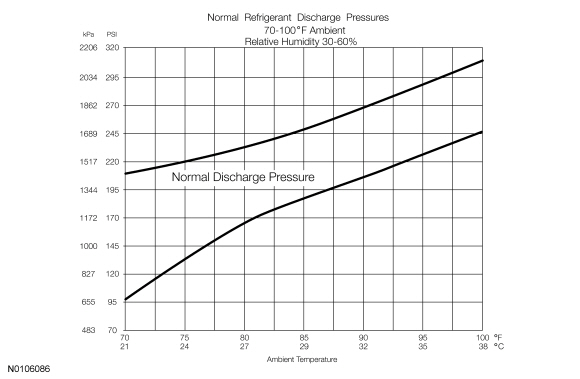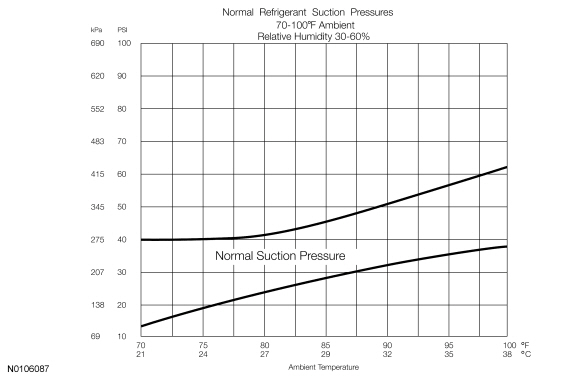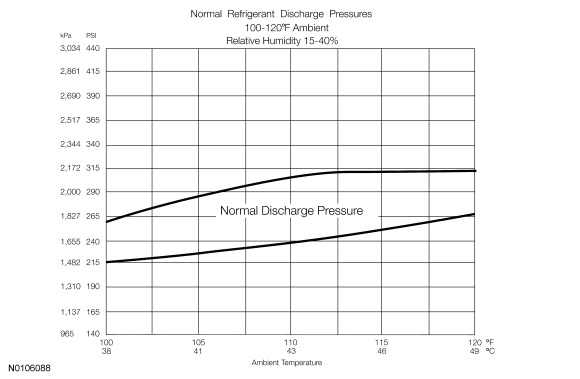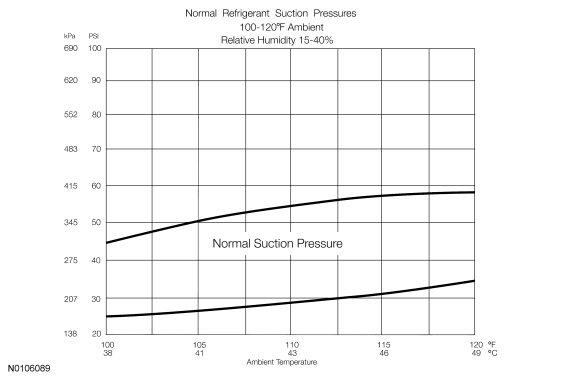Ford Focus Service Manual: Refrigerant System Tests

|
R-134a Manifold Gauge Set 023-00047 or equivalent |

|
R-134a Refrigerant Management Machine (SAE J-2788 Compliant) 023-00181 or equivalent |

|
R-134a Refrigerant Management Machine (SAE J-2788 Compliant) 199-00067 or equivalent |

|
R-134a Refrigerant Management Machine (SAE J-2788 Compliant) 265-00012 or equivalent |
Procedure 1 — Ambient Temperature at or Below 38°C (100°F)
NOTE:
The system performance can be evaluated and diagnosed by analysis of the compressor suction and discharge pressures. The following procedure is used to determine if the system is operating at normal pressures.
NOTE:
The procedure varies depending on the ambient (shop) temperature. If the ambient temperature is 38°C (100°F) or lower, follow Procedure 1. If the ambient temperature is over 38°C (100°F), follow Procedure 2.
NOTE:
If the A/C compressor cycles at any time during this test, refer to the diagnostic table.
- Drive the vehicle or run the engine until it reaches normal operating temperature.
- Connect an R-134a Manifold Gauge Set or R-134a Refrigerant Management Machine with high-pressure and low-pressure gauges to the refrigerant system.
- Set the A/C controls for normal A/C-PANEL mode, full COOL temperature, FRESH air, HI blower. If the vehicle has a fresh air/recirc button, set it to FRESH. If the vehicle has an A/C switch or compressor on switch, set it to A/C ON.
- Open all vehicle windows and leave the hood open for the test. Open the rear doors.
- Confirm the compressor clutch is engaged and the engine cooling fan(s) are operating or engaged. Allow the vehicle to idle until the suction (low-side) and discharge (high-side) pressures are stable or fluctuate in a range that repeats.
- Record the ambient (shop) temperature.
- Record the discharge pressure. If the pressure is fluctuating, record the average value.
- Determine if the discharge pressure falls within the normal operating limits using the Normal Refrigerant Discharge Pressures chart.

- Record the suction pressure. If the pressure is fluctuating, record the average value.
- Determine if the suction pressure falls between normal operating limits using the Normal Refrigerant Suction Pressures chart.

- Proceed to the Diagnostic Table.
Procedure 2 — Ambient Temperature Above 38°C (100°F)
NOTE:
The system performance can be evaluated and diagnosed by analysis of the compressor suction and discharge pressures. The following procedure is used to determine if the system is operating at normal pressures.
NOTE:
The procedure varies depending on the ambient (shop) temperature. If the ambient temperature is 38°C (100°F) or lower, follow Procedure 1. If the ambient temperature is over 38°C (100°F), follow Procedure 2.
- Drive the vehicle or run the engine until it reaches normal operating temperature.
- Connect an R-134a Manifold Gauge Set or R-134a Refrigerant Management Machine with high-pressure and low-pressure gauges to the refrigerant system.
- Set the A/C controls for normal A/C-PANEL mode, full COOL temperature, FRESH air, MED LO blower. If the vehicle has a fresh air/recirc button, set it to FRESH. If the vehicle has an A/C switch or compressor on switch, set it to A/C ON.
- Open all vehicle windows and leave the hood open for the test. Open the rear hatch and/or rear doors (if equipped).
- Confirm the compressor clutch is engaged and the engine cooling fan(s) are operating or engaged. Allow the vehicle to idle until the suction (low-side) and discharge (high-side) pressures are stable or fluctuate in a range that repeats.
- Record the ambient (shop) temperature.
- Record the discharge pressure. If the pressure is fluctuating, record the average value.
- Determine if the discharge pressure falls within the normal operating limits using the Normal Refrigerant Discharge Pressures chart.

- Record the suction pressure. If the pressure is fluctuating, record the average value.
- Determine if the suction pressure falls between normal operating limits using the Normal Refrigerant Suction Pressures chart.

- Proceed to the Diagnostic Table.
Diagnostic Table
- NOTE:
The following table is used to guide diagnosis of the refrigerant system if operating pressures are outside normal limits.
Refer to the chart below.
High (Discharge) Pressure Low (Suction) Pressure Component — Causes High or Clutch Cycling High Condenser — inadequate airflow. High Normal to High Engine — overheating. Normal to High Normal Refrigerant overcharge — air in refrigerant. Normal to Low Normal to High A/C suction line — partially restricted or plugged. a Normal to Low Low or Clutch Cycling Low refrigerant charge, A/C suction line — partially restricted or plugged. b Erratic Operation or Compressor Not Running Evaporator discharge air temperature sensor or A/C pressure transducer — poor connection at A/C clutch connector. A/C electrical circuit erratic — see A/C Electrical Circuit Wiring Diagram. Normal to Low High Compressor — low performance. Additional Possible Cause Components Associated With Inadequate Compressor Operation - Compressor Drive Belt — loose
- Compressor Clutch — slipping
- Clutch Coil Open — shorted, or loose mounting
- HVAC Module
- Clutch Wiring Circuit — high resistance, open or blown fuse
- Compressor Operation Interrupted by PCM
Additional Possible Cause Components Associated With a Damaged Compressor - Incorrect Clutch Air-gap
- Refrigerant Leaks
aLow pressure reading will be normal to high if restriction is downstream of service access valve.
bLow pressure reading will be low restriction is upstream of service access valve.
 Refrigerant Oil Adding
Refrigerant Oil Adding
Special Tool(s)
R-134a Loop/Add On Injector Kit-Set
219-00069 or equivalent
Material
Item
Specification
Motorcraft® PAG Refrigerant Compresso ...
 Compressor
Compressor
...
More about Ford Focus:
Ford Focus Transmission Fluid Drain and Refill
Material
Item
Specification
Motorcraft® MERCON® LV Automatic Transmission Fluid
XT-10-QLVC (US); CXT-10-LV12 (Canada)
MERCON® LV
With the vehicle in NEUTRAL, position it on a hoist. For additional information,
refer to Section 100-02.
Disco ...
